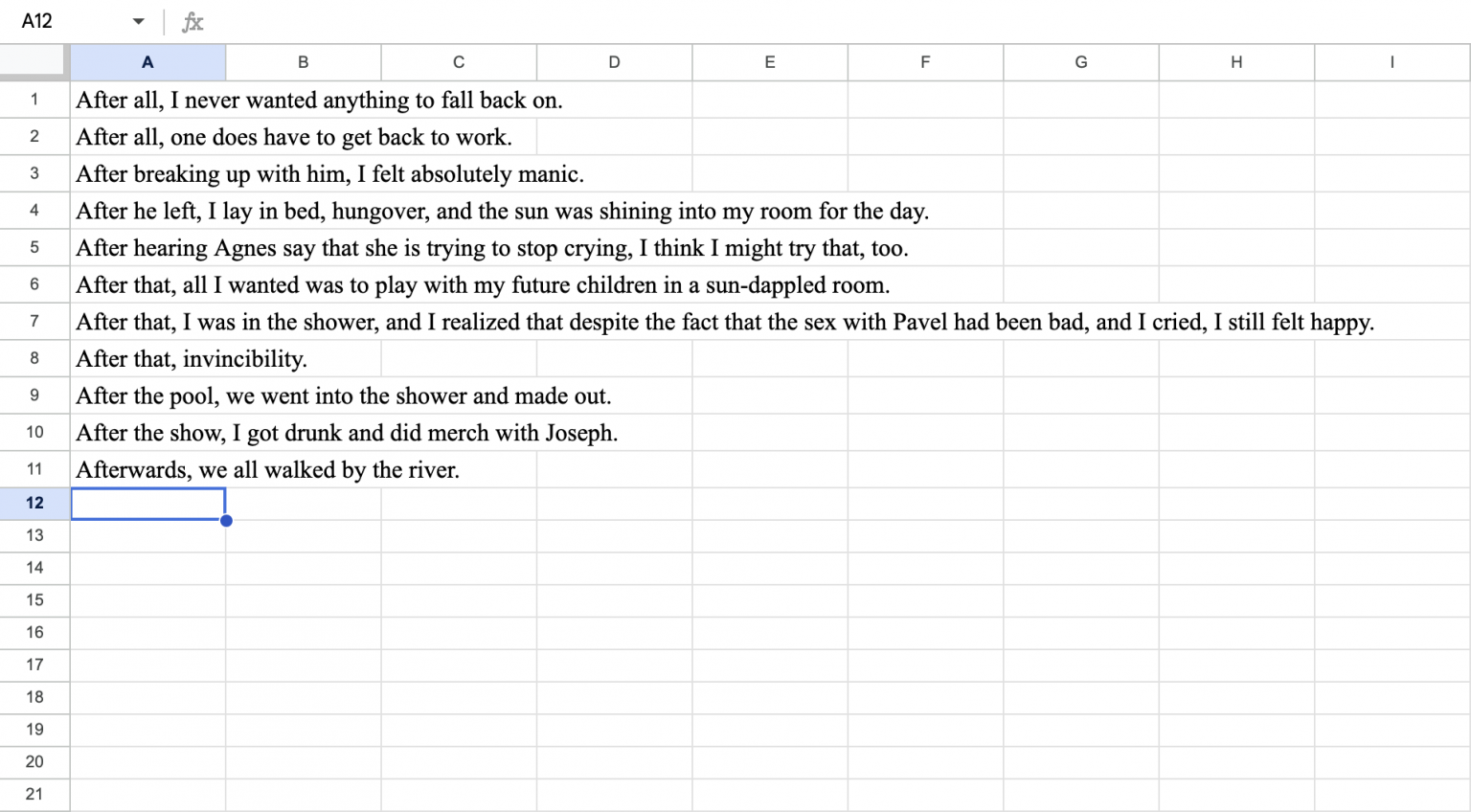Order and the Stable Self
What’s the meaning of a sentence? A paragraph? Linda Besner considers the abecedarian work that makes Sheila Heti’s Alphabetical Diaries so much more than an exercise in spreadsheet manipulation.

Where are Johanna Berndt and Laura Birks now? For years they sat, respectively, in front of and behind me in homeroom, until we trooped across our high school’s makeshift stage in the gym to receive our diplomas, our names punctuated with the kind of fresh applause that Ns and Rs can only dream of. We had a kind of fellow feeling that fell short of affinity; we could stand next to each other without being taken for friends. We were the Bs, and we did not, otherwise, have much in common.
In Sheila Heti’s new book, Alphabetical Diaries, she takes a decade’s worth of journal entries and lines them up like a bunch of middle-schoolers—alphabetically, by sentence. “A book,” the book begins. “A budget,” a few sentences later. “A bunch.” From the C section: “Came back here and worked and worked. Can I be happy in this way? Can I be truthful? Can I believe that things will turn out well when he and I are reunited?” (According to alphabetization rules, the blank space after “be” comes before the “l” in “believe.”) Heti’s mode of construction is old-school for our AI era; she copied each sentence of her diary into a separate cell of an Excel spreadsheet and clicked “sort A to Z.” However, the book I hold in my hands is only in a minor way the product of automation. The original spreadsheet held 500,000 sentences; the book Heti has made is a carefully crafted selection of only 60,000.
The alphabet is a system that feels both impersonal and personal. Everyone has letters they love best, along with a slew of other associations both idiosyncratic and shared. Studies of people with synaesthesia find a surprising level of agreement that the letter A is red. Studies of consumer culture suggest that people with last names that come later in the alphabet can be pressured to buy things with phrases like “while supplies last”—presumably influenced by a lifetime at the back of the line. When applied to something as private as a diary, alphabetization is both a distancing technique and an invitation to intimacy. We don’t know Heti’s friends, but the overarching relationship being highlighted here is one we all share.
*
The abecedarian or abecedarius is a poetic form as old as the Bible. Psalm 118 has 22 stanzas, each beginning with one letter of the Hebrew alphabet, and Chaucer wrote his “An ABC (The Prayer of Our Lady)” in the 14th century. In contemporary poetry, the form is typically snappier, proceeding through the alphabet line by line. “Because you used to leaf through the dictionary,/Casually, as someone might in a barber shop, and/Devotedly, as someone might in a sanctuary,” begins a 2012 poem by Jessica Greenbaum (the title, “A Poem for S,” supplies the A). The speaker bemoans the way that life’s petty chores have stolen S’ attention away from a semi-spiritual love of letters, and narrates the tale of how a
Jewish ancestor, horseback in the woods at Yom
Kippur, and stranded without a prayer book,
Looked into the darkness and realized he had
Merely to name the alphabet to ask forgiveness—
No congregation of figures needed, he could speak
One letter at a time because all of creation
Proceeded from those.
In the beginning was the Word, and the mystical power ascribed to the alphabet speaks to the way language sings our world into being. “A writer is just one person under the stars, one person in a universe, writing about a whole entire universe,” Heti writes, in the A chapter. Heti’s great subject, in this book as in her previous works, is self-creation. (And, of course, blowjobs; it's nice to picture Heti’s sentence "Blowjobs and tenderness" from Chapter B in cap and gown, waiting in the wings to receive its diploma between Bleakney and Blum). Creating works of art and creating the self are both, frankly, frightening undertakings. Results are unpredictable and the stakes are at once very low (there are billions of other people and other artworks) and extremely high (you can only ever be one person, and can create a limited number of things in your lifetime). In this sense, calling on the holy fire of the alphabet for help is an act of submission, a humbling before a power greater than oneself.
With alphabetization acting the muscle, Heti manages to loosen the grip of that other great organizing principle: time. We see characters get married, then get engaged; people may break up before they get together. “Grandma died. Grandma has been sick. Grandma is ailing still.” But it’s not a simple reversal. Time’s arrow points all over the map, and sentences churn to the surface according to no chronological rule, so that none of these actions has exactly happened. Instead, everything is in a continuous process of happening. It’s a constant motion that can feel like stasis, which is one of the frustrating things about being human.
An entrancing oddity of the book is the sentences that crop up more than once in slightly different forms. Under W: “When you don’t spend money, it adds energy to your art”; under N: “Not spending money adds energy to your art.” Under L: “Lemons moved to Paris for seven years and now he is back here, adjusting”; under H: “He moved to Paris for seven years and now he is back here, adjusting.” I’m going to assume that Heti wrote these thoughts in her diary at different times, but because we stay the same people to an annoying degree throughout our lives, her mind produced virtually the same phrasing.

There is a Steinian echo in the constant renewal and repetition. But where Gertrude Stein’s interventions took place at the level of the individual sentence, the unit of meaning being reimagined in Alphabetical Diaries is the paragraph. Some might argue that the book doesn’t contain paragraphs at all, since each chapter reads as one unbroken block of text (except chapter I, which breaks when a long series of “I” statements transitions to “ice cream”). The effect produced for this reader, however, is that each chapter reads as one long paragraph.
The paragraph is a somewhat understudied literary unit; where books have been written about the artistry of the sentence (Brian Dillon’s 2020 Suppose a Sentence comes to mind), little has been written by literary artists for literary audiences about the art of the paragraph. In high school, most of us were subjected to a rigid set of rules for essay-writing that stressed clear topic sentences and relentless repetition of a thesis statement and three subpoints. But in the wild, paragraphs written by adults for the entertainment of adults do not generally conform to this structure (even in essays, much less in other literary forms).
A genius of the alphabetical rule in Heti’s book is that it maximally transgresses and rigidly follows middle-school rules of paragraphing at the same time (it’s hard to escape the singsong echoes of one’s schooling in thinking about an alphabet book). Contemporary paragraph theory in the pedagogical context is based on a set of six principles devised by the English philosopher Alexander Bain in 1866. Some are of debatable currency (“When several consecutive sentences iterate or illustrate the same idea, they should, so far as possible, be formed alike”), but many remain highly recognizable. Alphabetical Diaries seems, at first, glance, to be all rebellion against statements like, “The bearing of each sentence upon what precedes shall be explicit and unmistakable,” or, “A paragraph should possess unity; which implies a definite purpose, and forbids digressions and irrelevant matter.” On second look, however, the formal constraint dictating sentence order follows these instructions to the letter. Each sentence follows unmistakably from the previous sentence just as Richard Tenn followed Richard Telmosse. The P chapter forbids any digressions into statements beginning with D, and possesses an undeniable unity. A book of randomized sentences would have produced a book as resistant to chronology and as questioning of sense, but it could not have made a book that also fulfills our desire to see a clear reason why one statement should lead to another.
*
In looking up other alphabetic efforts, I came across a version of The Wizard of Oz that had been recut with all of its dialogue in alphabetical order. It’s called Of Oz the Wizard, and starts out with an extended sequence of screams, subdivided into “Aaaaaaa!” and “Aiiiiieeee!” At some point in reading Heti’s book, I started to chafe under the knowledge that the delightful coincidences and lyrical misdirections were all by design—because Heti had chosen from quite a vast menu of options as to which sentences could be juxtaposed, I wasn’t really seeing what the alphabet as co-author could do. Unfortunately, however, Of Oz the Wizard is virtually unwatchable. An unedited version of the Alphabetical Diaries would have contained far more of the least fun parts of the book, in which sentences begin identically. It’s the sequences that pass quickly from Last night to Lately to Later to Laughter that feel to me most alive, not the long passages of Pavel did, Pavel said, Pavel thinks, Pavel was.
The crowning irony of the book may be that, for a work created to fulfill the exigencies of a cataloging system, it’s quite difficult to go back and find specific passages once read. I found one blowjob under B, but there are a dozen other descriptions of and references to blowjobs that appear inside sentences rather than as beginnings. And because there is no chronology, it’s hard to think back to when you read a sentence about a blowjob—events don’t have fixed locations in the book.
In a way, this makes an argument for the divisibility of the words we use to say things and the things we say. Certainly, the reader doesn’t emerge from Alphabetical Diaries with the sense that a form that offers a pleasing way to order one’s thoughts results in a coherence to their contents. A diary is a document of contradictions, an attempt to document an inner life that is itself coming into being through the process of documentation and description. Perhaps the whole notion of a stable self, even when framed with the two covers of a book and presented in accordance with the most rigorous rules, doesn’t really make sense at all.
The Drained Pool is a regular column for Arcade by Linda Besner.






